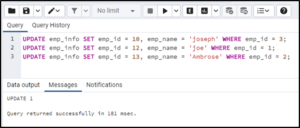The update query in SQL is a powerful tool that allows you to change data in your database. Whether you’re fixing a mistake or updating information, understanding how to use the update query in SQL is important for anyone working with databases.
In this post, we’ll explain what an update query does, how to write it, and give examples to make everything clear. Even if you’re new to SQL, don’t worry! This guide will make it easy to understand how to modify your data with the update query.
What is an Update Query in SQL?
An update query in SQL is used to change the existing data in a database table. This means if there’s a mistake or you need to modify a record, the update query allows you to fix it without deleting anything.
SQL stands for Structured Query Language, and it helps you manage the data in your databases. The update query works by locating specific records and updating them with new values. Understanding how this query works is essential for database management.
When working with databases, it’s common to encounter situations where data needs to be updated. For instance, if an employee’s address changes, you can easily modify it with the update query in SQL instead of adding a new record.
Why Use the Update Query in SQL for Changing Data?
Updating data is important because it helps keep your database accurate. Without an update query in SQL, you would need to delete and then re-enter data every time a small change is needed. This would be time-consuming and prone to errors.
By using the update query, you can quickly modify your data in one simple step. This also helps ensure the data remains consistent. Keeping records updated is vital, especially when managing large amounts of information.
Also, the update query is flexible. You can change one piece of data or multiple rows at once, making it an efficient way to handle updates in your database. SQL allows you to be specific about what you want to change and where.
How to Write a Basic Update Query in SQL (Step-by-Step Guide)
Writing an update query in SQL is straightforward. First, you need to specify the table where the data will be updated. Next, you define the new value you want to set. Finally, you use a WHERE clause to target the exact rows you wish to update.
Here’s a basic example:
sql
Copy code
UPDATE table_name
SET column_name = ‘new_value’
WHERE condition;
The UPDATE statement tells SQL that you want to modify the data. The SET part assigns the new value, and the WHERE clause ensures only the correct records are updated. Always double-check your WHERE clause to avoid unwanted changes.
New users should practice writing basic update queries with small datasets to get comfortable with the process. This helps reduce errors and improves confidence in managing data updates.
Updating Multiple Rows with the Update Query in SQL

Sometimes, you need to update more than one row at the same time. The update query in SQL makes this easy by allowing you to target multiple rows with a single query.
For example, if you want to give all employees in the same department a salary raise, you can update multiple rows in one go. This saves time and ensures consistency across the database. You can do this by modifying the WHERE clause to match all the rows you want to change.
The update query also works well with bulk updates. However, it’s always a good idea to back up your data before making large updates to avoid any accidental mistakes.
Using the WHERE Clause in the Update Query in SQL: Why It Matters
The WHERE clause is crucial when writing an update query in SQL. It helps you target specific rows in your table, so you don’t end up updating everything by accident.
Without the WHERE clause, SQL would change every record in the table. This is why it’s important to carefully define the conditions in the WHERE clause. For example, if you want to update only one employee’s email address, you can write:
sql
Copy code
UPDATE employees
SET email = ‘new_email@example.com’
WHERE id = 123;
By using the WHERE clause, you make sure that only the intended data gets modified. This adds an extra layer of control and prevents mistakes.
Updating Multiple Columns in Update Query in SQL
The update query in SQL can also be used to modify several columns at once. If you need to update different fields in the same row, you don’t have to write multiple queries. SQL allows you to do it all in one go.
Here’s an example:
sql
Copy code
UPDATE employees
SET name = ‘John Doe’, email = ‘johndoe@example.com’
WHERE id = 123;
With this query, you can change the employee’s name and email in one step. This is efficient and helps keep your queries clean and simple.
When updating multiple columns, remember to double-check each value before running the query. This ensures that all changes are made correctly.
Common Mistakes When Using the Update Query in SQL (and How to Avoid Them)
Even though the update query in SQL is simple, there are common mistakes people make. One big mistake is forgetting the WHERE clause, which can result in updating all records in the table instead of just a few.
Another mistake is using the wrong conditions in the WHERE clause. This can lead to unintended updates. Always check your WHERE clause carefully and test your query on a small dataset before running it on your main database.
It’s also a good idea to back up your data before making major updates. That way, if something goes wrong, you can restore the original data without losing anything.
Best Practices for Writing Efficient Update Query in SQL
To write effective update queries in SQL, it’s important to follow best practices. Always use the WHERE clause to narrow down your updates to specific records. This prevents unwanted changes.
Another tip is to avoid updating too many rows at once. Instead, break large updates into smaller batches to avoid performance issues. This is especially important for large databases.
Additionally, always test your queries before running them on live data. You can use a test environment to make sure everything works as expected without affecting your main database.
Can You Update Data Safely in SQL? Tips to Ensure Data Integrity

Maintaining data integrity is important when using the update query in SQL. One way to do this is by using transactions, which allow you to roll back changes if something goes wrong.
Another tip is to use constraints, like foreign keys, to ensure that your updates don’t break the relationships between different tables. These features help keep your database stable and prevent errors.
Lastly, always back up your database before running large updates. This ensures that if a mistake happens, you can easily restore the previous version of your data.
Conclusion
The update query in SQL is a powerful and simple tool that helps you change data in your database without much trouble. By using this query, you can easily fix mistakes or keep your records up-to-date. Just remember to always use the WHERE clause to make sure you’re only changing the right data. With a little practice, you’ll be able to write update queries like a pro!
Always be careful when making changes to your database, especially when updating multiple rows or columns. Testing your query before running it on important data is a good habit to have. As you learn more about SQL, the update query will become an important part of managing your data safely and quickly.
FAQs
Q: What is an update query in SQL?
A: An update query in SQL is a command used to modify existing data in a database table. It allows you to change specific records without deleting or re-entering data.
Q: How do I write a basic update query in SQL?
A: A basic update query follows this format:
sql
Copy code
UPDATE table_name
SET column_name = ‘new_value’
WHERE condition;
This changes the specified data in the chosen table.
Q: Why do I need to use the WHERE clause in an update query?
A: The WHERE clause is important because it targets specific rows. Without it, the query will update all rows in the table.
Q: Can I update more than one row at a time using SQL?
A: Yes, by adjusting the WHERE clause, you can update multiple rows at once, such as all rows that meet a certain condition.
Q: Is it possible to update more than one column in a single query?
A: Yes, you can update multiple columns in a single query by listing them after the SET keyword, separated by commas.
Q: What should I do before running an update query on important data?
A: Always back up your data before running an update query, especially for large or critical changes, to prevent data loss if something goes wrong.










